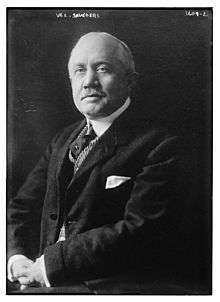Naval Consulting Board

_of_the_Naval_Consulting_Board_in_1916.jpg)
The Naval Consulting Board, also known as the Naval Advisory Board (a name used in the 1880s for two previous committees),[1] was a US Navy organization established in 1915 by Josephus Daniels, the Secretary of the Navy at the suggestion of Thomas Alva Edison.[2] Daniels created the Board during World War I, but two years before the U.S. entered the war, to provide "machinery and facilities for utilizing the natural inventive genius of Americans to meet the new conditions of warfare."[3] Daniels was worried that the U.S. was unprepared for the new conditions of warfare and that they needed access to the newest technology.[4]
History
Thomas Edison gave a speech in which he proposed a group of scientists should be involved with the World War I effort.
Josephus Daniels, the Secretary of the Navy asked Thomas Edison to be president of the board.[2]
William Lawrence Saunders later replaced Edison.
There were 24 original members, including Elmer Sperry, Peter Cooper Hewitt, Hudson Maxim, Matthew Bacon Sellers II, Howard E. Coffin, Andrew J. Riker, Thomas Robins, Willis Rodney Whitney, Leo Baekeland, Frank Julian Sprague, Benjamin Garver Lamme, Robert Simpson Woodward, Arthur Gordon Webster, Andrew Murray Hunt, Alfred Wingate Craven, William Lawrence Saunders, Benjamin Bowditch Thayer, Joseph William Richards, Lawrence Addicks, William Le Roy Emmet, Spencer Miller, and Henry Alexander Wise Wood.[5][6]
Later, the physicists Arthur Compton, Robert Andrews Millikan and Lee De Forest, inventor of the radio tube.
Initially the board had no legal status, budget or staff, and its mission was unclear. Not until August 1916 did the United States Congress appropriate $25,000 for its operation.
The initial publicity surrounding its creation resulted in a flood of suggestions about how to improve the US Navy's ships, totaling 110,000 during the war. The Board's members decided that they could be most effective if they divided into technical committees to utilize their specialist expertise, including the Committee on Aeronautics and Aeronautical Motors. They provided consultants and arranged for research to be carried out in established civilian laboratories.
During World War I, the board was responsible for approving camouflage schemes for civilian ships, including one invented by William MacKay. One of the most significant committees was that on Industrial Preparedness, which drew up an inventory of manufacturing capacity and sought to develop common manufacturing standards.
On 10 February 1917 the Board established a Special Problems Committee with a Subcommittee on Submarine Detection by Sound. This led to the collaboration of the Submarine Signalling Company, the General Electric Co and Western Electric Co in experiments on the problem. An experimental station was established at Nahant, Massachusetts.[7]
On May 11, 1917 the United States Secretary of the Navy created a Special Board on Antisubmarine Detection "for the purpose of procuring either through original research, experiment and manufacture, or through development of ideas and devices submitted by inventors at large, suitable apparatus for both offensive and defensive operations against submarines". Dr. Millikan of the United States National Research Council, Dr. Whitney of the General Electric Co., Dr. Jewett of the Western Electric Co., and Mr. Fay of the Submarine Signal Co. were appointed as advisory members.
References
- ↑ "On This Day: June 20, 1885". New York Times. 2001. Retrieved 2011-01-05.
- 1 2 "Thomas Edison's Vision". United States Navy. Retrieved 2013-12-18.
Secretary of the Navy Josephus Daniels seized the opportunity created by Edison's public comments to enlist Edison's support. He agreed to serve as the head of a new body of civilian experts - the Naval Consulting Board - to advise the Navy on science and technology. ...
- ↑ Pearson, Lee, Developing the Flying Bomb, Naval Air Systems Command
- ↑ L. N. Scott, Naval Consulting Board of the United States (Washington, 1920), 286
- ↑ Information Annual, 1915, A Continuous Cyclopedia and Digest of Current Events, R.R. Bowker Company (New York ,1916), 615
- ↑ "Daniels Names Naval Advisors. Announces Makeup of Board of Inventors Headed by Thomas A. Edison. Cooper Hewitt A Member. Hudson Maxim, Henry A. Wise Wood, Alfred Craven, and F.J. Sprague Other New Yorkers. Noted Engineers To Serve. Chemists, Aeronautical Experts, Inventors, and Authorities on Explosives Also Picked". New York Times. September 13, 1915. Retrieved 2013-12-19.
The makeup of the Naval Advisory Board of Inventions, the organization of experts, who will contribute their inventive genius to the navy, of which Thomas A. Edison is to be the Chairman, was announced by Josephus Daniels, the Secretary of the Navy, tonight.
- ↑ The Submarine Signalling Company, H J Fay, November 1944
 This article incorporates public domain material from websites or documents of the Naval History & Heritage Command.
This article incorporates public domain material from websites or documents of the Naval History & Heritage Command.
External links
- Naval Consulting Board of the United States by L.N. Scott [incomplete]